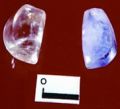Pendants and Amulets
Pendants and Amulets Pendants are decorative and are thought to be used as ornament mainly hanging with a necklace, on the other hand amulets are believed to have a magical as well as curative value and are thought to protect their possessors from the evil eyes or bad luck. In the Kaushika Shutra, it is stated that an amulet in the form of a ship ensures safe voyage. From the Vedic times, the axe-shaped amulet was used to restore an unjustly slandered man to honour. Tortoise- shaped amulets were symbolic of longevity. Amulets had been used for ritual purpose also. Large number of amulets were found on the chest of Egyptian mummies.
It has been observed in mummies displayed in the British Museum that there is specified place on the chest of a mummy for specific amulets. However, the main purpose of amulets is protection from diseases or winning over enemies or obtaining strength and virile power for attracting the opposite sex or propitiating angry deities and the like. It is not always easy to know the exact purpose of many amulets. There are several references of amulets in the Atharva Veda and its gloss the Kaushika Shutra and other Vedic literatures.
-
Bird pendant
-
Boat pendant (Agate)
-
Tooth pendant (Quartz and Amethyst)
-
Axe pendant (Carnelian)
-
Soft stone amulet
Pendants and amulets were in use in the subcontinent since Harappan period. Many archeological sites like bangarh, chandraketugarh, mahasthangarh, wari-bateshwar etc in Bengal have yielded a variety of amulets and pendants of different materials. Semi-precious stones were popular materials for amulets and pendants. However, the common shapes are axe, adze, drop, heart, boat, tooth, point, crescent etc. Such amulets and pendants have been reported from many sites in the subcontinent as well as in the world. The nature of the amulets and pendants from Bengal has exposed a cosmopolitan character of those sites.
It is a matter of great regret that, amulets and pendants from Bengal have not yet been exhaustively studied. There are several private collections in different parts of Bengal and reserve collection in Museums that are awaiting a proper study. [SS Mostafizur Rahman]





